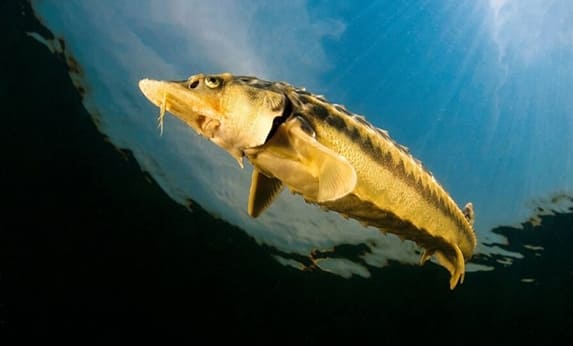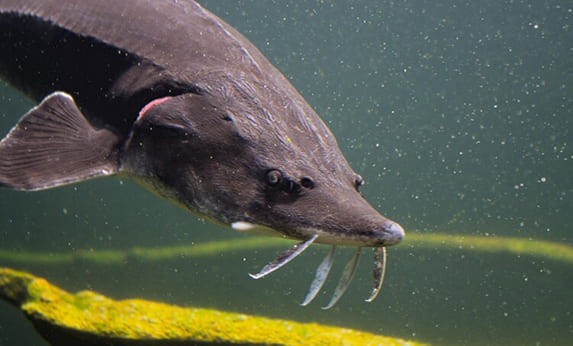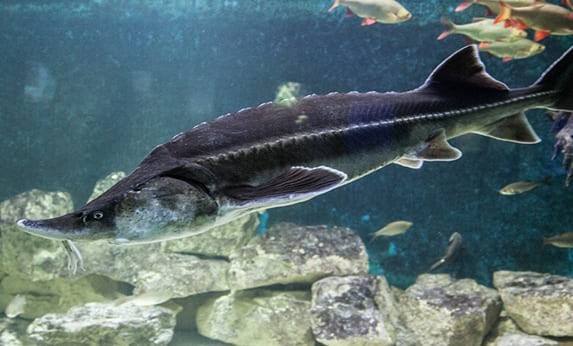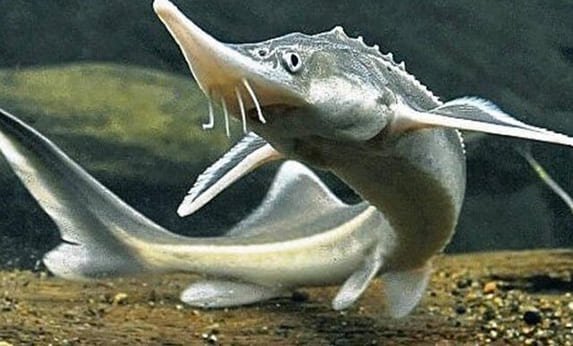OUR FISH
OUR FISH
DIAMOND STURGEON
Diamond Sturgeon it is listed as a “critically endangered” species on the IUCN Red List and is strictly protected by CITES.
The natural population of Diamond Sturgeon has declined by 90% in the last 45 years and is still declining. There is no record indicating any wild species caught in the Black Sea over the last ten years, which may indicate their potential extinction from that area.
Diamond Sturgeon reaches up to 1.5 metres and over 20 kilogrammes. Females reach sexual maturity at the age of 10-16, males at the age of 8-13. Adult females spawn every 4-6 years, males every 2-3 years from April to June. The life span is 38-48 years. Diamond Sturgeon is native to the Caspian Sea, Black Sea, the Sea of Azov and their river basins.
DIAMOND STURGEON
Diamond Sturgeon it is listed as a “critically endangered” species on the IUCN Red List and is strictly protected by CITES.
The natural population of Diamond Sturgeon has declined by 90% in the last 45 years and is still declining. There is no record indicating any wild species caught in the Black Sea over the last ten years, which may indicate their potential extinction from that area.
Diamond Sturgeon reaches up to 1.5 metres and over 20 kilogrammes. Females reach sexual maturity at the age of 10-16, males at the age of 8-13. Adult females spawn every 4-6 years, males every 2-3 years from April to June. The life span is 38-48 years. Diamond Sturgeon is native to the Caspian Sea, Black Sea, the Sea of Azov and their river basins.
SIBERIAN STURGEON
Listed as an “endangered” species on the IUCN Red List and protected by CITES, this species has experienced a 50-80% population decline over the last 60 years. Siberian Sturgeon reaches up to 2 metres in length and typically weighs around 65 kilogrammes. The maximum recorded weight is 210 kilogrammes.
As with all other ‘acipenserids’, the Siberian sturgeon is long-lived (up to 60 years), and late to reach sexual maturity (for females it is 11 – 22 years and for males 9 – 19 years, depending on the temperature of the water). Adult female fish spawn every 3-5 years and male every 2-3 years. The life span of Siberian sturgeon is typically 25-30 years.
SIBERIAN STURGEON
Listed as an “endangered” species on the IUCN Red List and protected by CITES, this species has experienced a 50-80% population decline over the last 60 years. Siberian Sturgeon reaches up to 2 metres in length and typically weighs around 65 kilogrammes. The maximum recorded weight is 210 kilogrammes.
As with all other ‘acipenserids’, the Siberian sturgeon is long-lived (up to 60 years), and late to reach sexual maturity (for females it is 11 – 22 years and for males 9 – 19 years, depending on the temperature of the water). Adult female fish spawn every 3-5 years and male every 2-3 years. The life span of Siberian sturgeon is typically 25-30 years.
BELUGA HYBRID
Beluga (Huso huso) x Sterlet (Acipenser ruthenus)
Due to the lack of availability of Beluga caviar and the complexity of farming the species, many producers began cross-breeding Beluga with other faster-producing sturgeon species.
Our Beluga Hybrid is the result of cross-breeding Beluga with Sterlet sturgeon and is widely referred to as Bester. Bester was first produced in the former Soviet Union at the Teplovsky fish farm in the Saratov region in1952.
It is a unique product that exhibits the size and flavour profile of Beluga with the early maturity of the smaller Sterlet sturgeon, providing an alternative to the limited supplies of Beluga.
Males reach maturity at 8-9 years and 9-14 years for females. Bester typically grows to about 30 kilogrammes and 1.8 metres in length. Lifespan can be between 20-40 years.
BELUGA HYBRID
Beluga (Huso huso) x Sterlet (Acipenser ruthenus)
Due to the lack of availability of Beluga caviar and the complexity of farming the species, many producers began cross-breeding Beluga with other faster-producing sturgeon species.
Our Beluga Hybrid is the result of cross-breeding Beluga with Sterlet sturgeon and is widely referred to as Bester. Bester was first produced in the former Soviet Union at the Teplovsky fish farm in the Saratov region in1952.
It is a unique product that exhibits the size and flavour profile of Beluga with the early maturity of the smaller Sterlet sturgeon, providing an alternative to the limited supplies of Beluga.
Males reach maturity at 8-9 years and 9-14 years for females. Bester typically grows to about 30 kilogrammes and 1.8 metres in length. Lifespan can be between 20-40 years.
STERLET
Is the smallest sturgeon species typically reaching 1 metre in length and 6.5 kilogrammes in weight.
Sterlet used to be the most common and abundant sturgeon in Western Europe. Its natural habitats are freshwater rivers that flow into the Caspian and Black Seas. Nowadays sterlet is listed as “vulnerable” on the IUSN Red List or as a threatened species and protected by CITES.
The natural population of Sterlet has critically declined and this species is considered endangered and is currently on the brink of extinction. It is for this reason that nearly all the Sterlet caviar in the international gourmet food market is harvested and produced on aquafarms scattered all over the world. These controlled conditions ensure a consistent high quality and predictable flavour to the caviar.
“Sterlet Sturgeon” is much smaller than the giant sturgeon species such as Beluga, Kaluga or even Osetra. The small size of Sterlet predetermines its relatively short life span and is also the reason for a faster maturation period which makes the farming of these species more convenient and efficient. In general, males mature after 3 – 12 years and females after 4 – 12 years. Sterlet can live up to 22 years in aquafarms.
STERLET
Is the smallest sturgeon species typically reaching 1 metre in length and 6.5 kilogrammes in weight.
Sterlet used to be the most common and abundant sturgeon in Western Europe. Its natural habitats are freshwater rivers that flow into the Caspian and Black Seas. Nowadays sterlet is listed as “vulnerable” on the IUSN Red List or as a threatened species and protected by CITES.
The natural population of Sterlet has critically declined and this species is considered endangered and is currently on the brink of extinction. It is for this reason that nearly all the Sterlet caviar in the international gourmet food market is harvested and produced on aquafarms scattered all over the world. These controlled conditions ensure a consistent high quality and predictable flavour to the caviar.
“Sterlet Sturgeon” is much smaller than the giant sturgeon species such as Beluga, Kaluga or even Osetra. The small size of Sterlet predetermines its relatively short life span and is also the reason for a faster maturation period which makes the farming of these species more convenient and efficient. In general, males mature after 3 – 12 years and females after 4 – 12 years. Sterlet can live up to 22 years in aquafarms.












